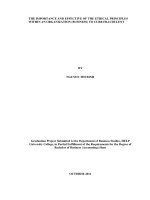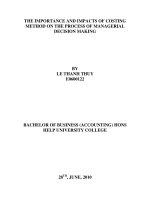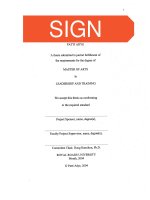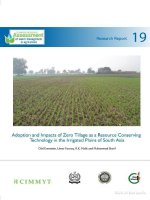the importance and impacts of costing method on the process of managerial decision making
Bạn đang xem bản rút gọn của tài liệu. Xem và tải ngay bản đầy đủ của tài liệu tại đây (546.93 KB, 74 trang )
THE IMPORTANCE AND IMPACTS OF COSTING
METHOD ON THE PROCESS OF MANAGERIAL
DECISION MAKING
BY
LE THANH THUY
E0600122
BACHELOR OF BUSINESS (ACCOUNTING) HONS
HELP UNIVERSITY COLLEGE
28
TH
, JUNE, 2010
THE IMPORTANCE AND IMPACTS OF COSTING METHOD ON THE
PROCESS OF MANAGERIAL DECISION MAKING
BY
LE THANH THUY
Graduation Project Submitted to the Department of Business Studies, Help
University College, in Partial Fulfillment of the Requirements for the degree of
Bachelor of Business (Accounting) Hons
JUNE, 2010
i
Declaration
I hereby declare that the graduation project is based on my original work except
quotations and citations which has been duly acknowledged. I also declare that it has not
been previously or concurrently submitted for any other course/degree at Help University
or other institutions. The word count is 12,295 Words.
ii
Acknowledgement
First of all, I am grateful to Dr Le Van Lien who gave lots of useful advices as
well as materials for this thesis. And I would like to extent my thanks to Mr. Minh,
manager and all of employees in Minhnhat Co., Ltd, who allowed and assisted me to
collect all of necessary information to finish this thesis. My thesis can not be finished
without your supports.
iii
TABLE OF CONTENT
Declaration i
Acknowledgement ii
TABLE OF CONTENT iii
Abstract v
List of tables vi
List of figures vii
CHAPTER 1: INTRODUCTION 1
1.1. Introduction of topic 1
1.2. Issues 3
1.3. Issues expansion 4
CHAPTER 2: LITERATURE REVIEW 6
2.1. Managerial decision making process 6
2.1.1. Decisions in nature 7
2.1.2. What is decision making process? 9
2.1.3. What is accounting information? 10
2.1.4. Managers and management accounting 12
2.2. The importance and Impacts of costs accounting methods on decision making
process of the managers using SWOTs and Porter’s model analysis. 14
2.2.1. Absorption costing 15
2.2.2. Variable costing method 17
2.2.3. Activity based costing system (ABC) 19
2.2.4. The importance and impacts of accounting methods on managerial decision
making process 21
2.2.4.1. SWOTs analysis and why managers should choose a suitable costing
method or importance of these methods. 21
2.2.4.2. Porter’ model with five factors which can affect the managerial decision
of managers in term of cost accounting methods 24
Figure 1: Porter’s model with five factors. 25
CHAPTER 3: RESEARCH AND METHODLOGY 29
3.1. Aims of the project 29
3.2. Research methodology 30
3.3 Data sources 30
3.4. Limitation 31
CHAPTER 4: CASE STUDY ANALYSIS 33
4.1. Introduction 33
4.1.1. Company’s background and mission statement 34
4.1.2. Operational structure 36
Figure 2: Operational structure of Minhnhat Company. 36
4.1.3. Firm core business and competitive advantages 37
4.2. Differences when using different cost accounting methods 38
4.2.1. Incurred expenses during the period of 2008-2009 39
Table 1: Production of Minhnhat Company 39
iv
Table 2: Direct material cost of Minhnhat Company 40
Table 3: Direct labor costs of Minhnhat Company 41
Table 4: production of Minhnhat Company 41
Table 5: Selling and administration expenses of Minhnhat Company 43
Table 6: Cost pool and activities measures of ABC method. 44
Table 7: Total manufacturing overhead and selling expense during the year of
Minhnhat Company 45
Table 8: Distribution of resources across activities costs pools of Minhnhat
Company 45
Table 9: Distribution of resources across activities costs pools in $ of Minhnhat
Company 46
Table 10: Activities rate of Minhnhat Company 47
4.2.2. Unit cost product using three methods to calculate 47
Table 11: Cost per unit of raincoats using variable and absorption costing 48
Table 12: Overhead cost per unit of adults’ raincoat and children raincoat using
ABC method. 50
4.2.3. A profit comparison using absorption, variable and ABC costing method to
calculate. 51
Table 13: Direct Materials and Direct Labor costs of Minhnhat Company 52
Table 14: Income statement of Minhnhat Company using ABC costing method . 53
4.3. The cost accounting method that Minhnhat Company uses and its impacts on their
decision making process 54
Figure 3: Income comparison between variable and absorption costing method:
Income statements for 2009 of Minhnhat Company 56
CHAPTER 5: CONCLUSION 57
References: 60
v
THE IMPORTANCE AND IMPACTS OF COSTING METHOD ON THE
PROCESS OF MANAGERIAL DECISION MAKING
BY
LE THANH THUY
JUNE, 2010
Supervisor: Dr. LE VAN LIEN
Abstract
In general, cost accounting method can be considered as the most concerning problem
with an organization. Different costing methods will lead to different profit to a firm.
This means choosing a cost accounting method can affect the decisions of managers
based on the empirical study of advantages and disadvantages of three costing methods
which are absorption, variable and ABC costing method. Many people think that there
are no links between the managerial decisions and cost methods, but I think they have a
potential relationship. As a result, I will use SWOT and Porter’s model to explore some
evidences about this connection. After that, I make some recommendation about the
importance and impacts of cost accounting method on the managerial decision making
process.
vi
List of tables
Table 1: Production of Minhnhat Company
Table 2: Direct material cost of Minhnhat Company
Table 3: Direct labor costs of Minhnhat Company
Table 4: production of Minhnhat Company
Table 5: Selling and administration expenses of Minhnhat Company
Table 6: Cost pool and activities measures of ABC method
Table 7: Total manufacturing overhead and selling expense during the year of Minhnhat
Company
Table 8: Distribution of resources across activities costs pools of Minhnhat Company
Table 9: Distribution of resources across activities costs pools in $ of Minhnhat Company
Table 10: Activities rate of Minhnhat Company
Table 11: Cost per unit of raincoats using variable and absorption costing
Table 12: Overhead cost per unit of adults’ raincoat and children raincoat using ABC
method
Table 13: Direct Materials and Direct Labor costs of Minhnhat Company
Table 14: Income statement of Minhnhat Company using ABC costing method
vii
List of figures
Figure 1: Porter’s model with five factors
Figure 2: Operational structure of Minhnhat Company
Figure 3: Income comparison between variable and absorption costing method: Income
statements for 2009 of Minhnhat Company
1
CHAPTER 1: INTRODUCTION
In this part, the structure of this thesis, an introduction about the topic as well as
relates issues to it will be covered. This will create the whole picture about the ideas and
help the users easy to follow and link them to each other to figure out the potential
relationship between cost accounting methods and managerial decision making process
that the author mentioned in the abstract.
1.1. Introduction of topic
A fire at the headquarters of the National Association of Accountants (NAA) in
1984 destroyed all information related to cost accounting aspect (Cunagin, C., & Stancil,
J., L., 1992). As a result, none accountants as well as historical researchers can ensure
and show evidences about the accurate time when the cost accounting methods are born.
As Richard Vangermeersch, a leading accounting historian said ‘a problem in cost
accounting is that many such accountants feel that they have no past’ (1986). Therefore
even costing management accounting is not a new problem but its importance is just
focused and researched in the twentieth century.
There are many methods to calculate the costs such as absorption costing method,
variable method, throughput accounting, and lean accounting and so on. Each of method
will have different way to allocate costs. As a result, with the same company, applying
two methods can lead to different decisions. In order to make a managerial decision,
2
costing methods play important roles. In fact, cost allocating can be considered as a
guideline for the managers to make better decisions. By comparing annual reports,
managers can see which profitable products are as well as whether any costs are wasted
or used inefficient. For some managers especially of the small company, absorption
costing might be the best costing method while it can deal with the conflicts of interests
between them and their companies. Other managers think that if they use another type of
costing methods to reduce and allocate costs more efficiency will improve their
performance more than using absorption costing method. However, this does not mean
with the same information or report, different managers will make the same decisions.
This process is depended on capability of each person. Therefore, to sum up, managerial
decision making process of managers is affected by many factors but in this thesis, only
impacts of cost accounting methods are discussed.
This thesis is divided into five chapters as follow:
Chapter 1: Introduction
Chapter 2: Literature review
Chapter 3: Research and methodology
Chapter 4: Case study analysis
Chapter 5: Conclusion
These five parts are not separated, they will be linked in order to express the ideas
that the author would like to share. Chapter 2: literature review and chapter 4: case study
analysis will be the most important parts which focus on the theory and the fact in a real
3
case. Chapter 1 and chapter 3 will considered as a background to create the general ideas
of this thesis. And chapter 5 will conclude the findings after analyzing a real case
compare to the theory.
1.2. Issues
Main ideas which are expressed in this thesis include the cost accounting methods
introduction, advantages and disadvantages of them and it impacts on the decision
making process of managers.
As mentioned above, history of cost accounting method is necessary to know
especially for three methods that the author wants to focus: absorption costing method,
variable costing method and Activities Base Costing method (ABC). It is difficult to
ensure that which costing method is applied first because of lacking documents about
this. But, for some historical researchers, absorption costing or traditional costing method
can be considered as the leader of cost accounting. After that, variable costing was born
and later ABC is invented. The same limited resources and costs, these three method lead
to different results as well as decisions. Each method will apply a way to allocate costs
which differ with the other two methods. Nothing can be perfect therefore these methods
contain both advantages and disadvantages to managers.
Using SWOTs model, all of advantages and disadvantages will be judged fairly.
SWOTs mean strengths, weakness, opportunities and threats. This model is used popular
4
in management aspect. Some people do not believe that SWOTs can be applied to
analyze in accounting. However, accounting does not mean only work with numbers
especially with managerial accounting. Managers also need ability to evaluate the
effectiveness and efficiency of the firms, the operation process and cost budget through
numbers. Moreover, through this evaluating, it will be easier to see the importance of cost
methods on the decisions making process.
Porter’s model is another management framework that the author uses in this
thesis. Unlike SWOTs, this model will focus on five factors which can have significant
impacts on the decisions of managers which are new entrances, buyers, suppliers,
substitutes and rivalry competitors. These will affect the cost available for the firms and
lead to changes in result when calculating costs using different methods. Then, decisions
of managers can be changed also.
1.3. Issues expansion
Theories are still theories if we can not apply them into the reality. As a result, in
chapter 4, a real case of MinhNhat company – one raincoat manufacturers will be use to
analyze. In this part, from the collected cost information of this company, absorption
costing method and variable costing method are applied. In fact, this company prefers
absorption costing rather than variable costing method because the increasing trend in
profit can attract more investors. But they had to turn into a new costing system which is
5
a combination between absorption costing method and ABC costing method from 2007
because of managerial wrong decisions during the use of absorption costing method.
According to Mr. Minh, manager of this company, applying absorption costing is
good for external reports especially for investor attracting purposes. However, this can
lead to mistakes in internal control process. As a result, a suggestion for a new system in
which variable and absorption costing methods coexists should be concerned by
accounting researchers.
6
CHAPTER 2: LITERATURE REVIEW
Like the first part of introduction, this will provide information about managerial
decision making process and three cost accounting methods. Understanding about the
decision making process in general and in costing management can help the managers
know what kind of information and how much of information do they need to make an
efficient decisions. From this, a briefly introduction about the history, calculation and
contents of absorption costing method, variable method and ABC method will be
covered. In the last of this chapter, SWOT and Porter’s model will be used to evaluate the
advantages and disadvantages as well as impacts of cost accounting methods on the
decisions of managers.
2.1. Managerial decision making process
Every body has to make decisions. Depending on different purposes of various
groups of people, decisions can be made differently in a specific circumstance. In order to
understand what managerial decision making process is, this part will explain:
- What are decisions in nature?
- How many steps do this process involves?
- What is accounting information?
- And how the managers use this information?
7
2.1.1. Decisions in nature
Decision process could be considered as a study in which the decision makers try
to overcome distractions from both internal and external to identify and choose the best
alternatives for a certain problem in a specific circumstance.
Every day, every second, we have to make decisions from small to important
things. For example, in the morning, we decide which kinds of clothes we will wear
today; then we decide whether to have a breakfast at home or bring some things such as
an apple to the school then taste it in the break time or lunch. More important than these
things, we decide our job in the future, salaries that we desire.
With a limited resources and time, we could not do many works at the same time.
As a result, making the best decision is very important which means it is not only suitable
with our ability but also can bring our best results (König, T.; Debus, M.; & Tsebelis, G.,
2010). According to most of people especially businessman, to make a good decision,
they need a lot of necessary information. However, in fact, we could not wait until we
have enough information to make a decision. For instance, we decide which major we
will follow in the university. We can not wait until we have enough statistics about all
major to make a decision. Although every student want to study a major which can help
them find a job better, they have to decide without thinking or planning so much.
Depending on different people as well as knowledge and experiences, decisions
will be different (Engel, C.; & Singer, W., 2008). Generally, many people though that
8
they are only affected by their own decisions whereas their parents, friends, bosses and
colleagues’ decisions also affect them (Lucius, C., 2009). This can be minor or
significant influences based on the relationship between them. For example, our parents
decide to live in countryside. As a result, our appearances as well as our characteristics
and thinking will be different with other children who live in big cities. This means our
decisions or other people’s decisions could affect the rest of our life by shaping our
attitudes and believes (Brunsson, N., 2007).
In some circumstances, decisions should be made by a group of people instead of
an individual (Egenhofer, C.; Kaczynski, P., M.; Kurpas, S.; & Schaik, L., V., 2010).
This is popular when teamwork is more and more important and developed nowadays.
Some people think that this is not sufficient because of including lots of judgments as
well as estimations. However, a person could not know every thing of various aspects;
more people can have better ideas if they know how to pass all of distractions such as
negligence and noise which is mentioned in the book named ‘Better Than Conscious?:
Decision Making, the Human Mind, and Implications For Institutions’ of Eapen, G.,
(2009). When the globalization becomes a dominated trend, making the best decision
while still maintaining the Code of ethics is the most desired goal that all of businessman
especially investors want to achieve.
9
2.1.2. What is decision making process?
In management, decision making process includes six steps which are
recognition of decision requirement, diagnosis and analysis causes; development the
alternatives; selection of desired alternatives; implementation and chosen alternatives;
and evaluation and feedback (Richard, L. D., 2009). With the same meaning of making
decision process but shorter, there are only four steps that decision makers should
concern when they make decisions (Hoggett, Edward, & Merlin, 2006).
First step is establishing the goal. With managerial accountants as well as
investors, different situations will lead to different decisions. Based on available
resources such as time and capital, decision makers should know whether the decisions
they make could be the best alternatives. This means is that determination is needed and
necessary to achieve the goals that we desired. In case this is important, all of our values
as well as motives will be affected.
Gathering available information is the second step. There are various kinds of
information. As a result, what kind of information do we need and how much of
information is needed are two important questions. If we collect too much information,
our judgments and attitude can be changed and not wise any more. Relevant information
can help us make better decisions with higher successful degree whereas irrelevant
information leads to distractions during our decision making process.
10
After collecting enough and useful information, we have to think how many
alternatives available for our decisions. In fact, we can not avoid uncertainty because
what we expect is in the future. Therefore, we only can make the best decisions within
limited resources in specific circumstances.
When we know what are available alternatives and their consequences, we have
to decide and make a plan which can help us achieve the outcomes we expect. Although
this process has only four steps but it still reflects the nature of making decision process.
This can help both accountants and investors have better thinking and judgment when
they face with any problems or opportunities.
2.1.3. What is accounting information and its role in decision making
process?
Information plays an important role in making decision process as mentioned
above. Thanks for the development of internet, accessing information becomes easier and
easier (Saaty, T., L.; & Vargas, L., G., 2009). But this does not mean all of information
are useful for our decision making process. Overload of information, the motives and bias
of providers, remoteness of information and complex transactions make the decision
makers face a higher information risk possibility (Alvin, A.A.; Randal, E. J.; Beasley; &
Mark; 2010).
11
Not many information could be considered as accounting information. Nature
of accounting is identifying, measuring and recording all transactions of an entity,
therefore, accounting information must reflect actual financial events of that entity
(Romney, M., B.; & Steinbart, P., J., 2008). Although this information can not guarantee
the future events but it can help the decision makers reduce the uncertainties. In other
words, historical records can be a useful guideline for both managerial and invested
decision makers. From this, mater budget can be prepared to show the business goals of
the entity in the new period. Additionally, through differences between the actual and the
budgeted numbers, decisions makers can adjust and drive the business into an effective
way.
By comparing the effectiveness and efficiency of an entity’s performance year
to year, accounting information could provide a wide view to users about which activity
could their core business categories and how could they allocate the costs more precisely
(Hurt, R., L., 2009). All of this information will be updated and filed day by day
(Bagranoff, N., A.; Simkin, M., G.; & Norman, C., S., Ph.D. CPA, 2009). As a result, if
the outcomes are not as decision makers’ expectation, an investigation will be
implemented to ensure whether a new decision should be made.
Depending on specific needs and positions of users, accounting information can
be judged important or not. For example, for some investors, profitability and earning per
share are key information when they decide to invest while others think it needs more
criteria such as CSR reports (Coenen, F., H., J., M., 2010) . This means the same
12
accounting information can be important or not based on the knowledge as well as
precisely judgments of users.
2.1.4. Managers and management accounting
Both internal and external users want to collect and use accounting information
probably. As mentioned above, managers try to use the accounting information in order
to enhance the efficiency as well as the effectiveness of allocating limited resources.
Comparing figures from year to year can draw a better picture about the running
business. As a result, they will plan a master budget as a bench mark to evaluate the
performance of a business. According to two authors, Atrill, P., & McLaney, E.,
depending on the requirements of decisions, managers may require daily, weekly or
monthly reports which are designed in differently forms and purposes (2009). For some
special accounting reports, internal auditors can be involved in verification process.
Unlike managers, investors use accounting information in others purposes. As a result,
they will access accounting information in different ways as well as types. In this thesis,
managers will be the main users that we concern.
Unlike reporting information which is reported to external users such as investors
and suppliers, management or managerial accounting tents to provide all of financial and
all of necessary information within an organization to managers to help them take their
responsibilities in planning, controlling and deciding activities (Tremmel, J., C., 2009). In
13
general, the common questions that perform the expectations and purposes of managers
include:
- What is the profit after taxes is being earned of our company?
- What resources are available?
- Do they have CSR reports?
- Should we invest and produce in these products?
It is difficult to satisfy all of investors’ needs. Therefore, by disclosure the
financial statements, managers will try to release and provide general information about a
corporation fairly among investors.
Reducing risks and enhancing wealth can be considered as dominated trends for
most of managers (Proctor, R., 2009). As a result, no managers want to decide while they
have not got enough information. Figuring out the differences between pieces will be
harder than looking at the whole picture and comparing although it can minimum the
risks of the organizations. Therefore, collecting accounting information from annually
reports might be a good way to draw a conclusion. This will let mangers broaden their
point of views and have better judgments during their decision process. Moreover, too
much and to detailed accounting information will lead to overload the information and
affect managers’ attitudes and a misstated decision can be made.
However, no one can ensure that all of information provided by the corporation is
accuracy and objectively. Sometimes, to get a higher profit and a better performance,
14
managers and accountants can cook the numbers. Therefore, investors need helps from
the third party – external auditors to maintain the fair and objectivity of accounting
information which are given by the managers.
2.2. The importance and Impacts of costs accounting methods
on decision making process of the managers using SWOTs and
Porter’s model analysis
Generally, cost accounting is the way to calculate costs and price of the products.
It can be used to help managers understand the costs of running a business (Weygandt, J.,
J.; Kimmel, P., D.; & Kieso, D., E., 2009). The appearance of larger business scales
needs another costing method to use. In the early industrial age, investments in the direct
labor, direct materials and manufacturing overhead costs which are included in variable
cost now can be considered as directly guide for deciding costs and price of products.
However, after a long time of using variable costs, accounting scientists figured out that
some cost such as maintenance, tooling, production control, purchasing, quality control,
storage and handling, plant supervision and engineering are remained the same during the
business period without concerning the volume of work (Shim, J., K., Ph.D.; & Siegel, J.,
G., Ph.D.; 2009). As a result, they are called ‘fixed costs’. Over time, these costs are
more and more important. However, until the twenty-first century, its importance is
identified clearly (Stenzel, C., & Stenzel, J., 2002).
15
There are many types of costing accounting methods such as absorption costing
method, variable costing method, ABC method, throughput costing method, lean costing
methods, etc (Vanderbeck, E., J., 2009). But in this thesis, only the first three methods are
analyzed.
By applying different costing accounting method, decisions made by managers
will be diversified. As a result, in the last part, SWOTs model will be used to analyze.
This means in this part, strength as well as weaknesses, opportunities and threats of each
method will be analyzed in order to evaluate the impacts of each method on the
managerial decisions making process.
2.2.1. Absorption costing
It is quite difficult to identify the time that absorption cost is invented. This is
because all of related and important documents of cost accounting were lost in a fire at
the headquarters of the National Association of Accountants (NAA) in 1984 (Cunagin,
C., & Stancil, J., L., 1992). However, this method can be consider as an origin of other
latter cost accounting methods such as variable costing and ABC costing. And this is also
known as traditional costing method.
According to this method, both variable costs and fixed costs are calculated as
inventories’ costs (Horngren, C., T.; Datar, S., M; Foster, G.; Rajan, M.; & Ittner, C.,
2009). In other words, administration expenses such as marketing and research and
16
development costs also are parts of manufacturing costs. Therefore, this method is also
called full costing method. A unit of production cost includes direct material; direct labor
and manufacturing overhead costs and only a part of the fixed manufacturing overhead
cost is allocated along with the variable manufacturing overhead cost (Balakkrishnan, R.,
Sivaramakrishnan, K., & Sprinkle, G., 2008). Like the definition of absorption costing
method, a unit product cost can be calculated by added the total variable manufacturing
overhead costs including direct material, direct labor and variable manufacturing
overhead costs with the fixed manufacturing overhead costs (McWatters, C.;
Zimmerman, J., L.; & Morse, D., 2008). This amount will be treated as cost of good sold
on the income statement. Similarly, ending inventories will be carried forward to the next
period on the balance sheet. For example, to make an ice cream, a company has to pay
$11 which is included $1 of material, $2 per hour of hiring an employee, $3 of variable
manufacturing overhead and $5 of fixed manufacturing overhead costs. Generally, fixed
manufacturing overhead costs per unit can be calculated by dividing the annually fixed
manufacturing costs to the number of produced products. For instance, in this case, this
company produces 10,000 ice-creams annum with the fixed manufacturing cost is
$50,000. As a result, fixed manufacturing cost will be $5 ($50,000/10,000units).
On the income statement, cost of good sold in this example will be $110,000
(10,000units x $11/unit). Continue with the example above, assume that this company
still remains 1000 ice-cream as ending inventories at the end of the year; $5,000 will be
assigned as ending inventory value on the balance sheet under this costing method. By
this way, the higher ending inventory value will lead to lower expenses and higher net









